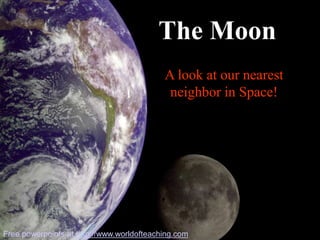
Our Lunatic Neighbor: The Moon
- 1. A look at our nearest neighbor in Space! The Moon Free powerpoints at http://www.worldofteaching.com
- 2. What is the Moon? • A natural satellite • One of more than 96 moons in our Solar System • The only moon of the planet Earth
- 3. Location, location, location! • About 384,000 km (240,000 miles) from Earth • 3,468 km (2,155 miles) in diameter (about ¼ the size of Earth)
- 4. The Moon’s Surface • No atmosphere • No liquid water • Extreme temperatures – Daytime = 130C (265°F) – Nighttime = -190C (-310 F) • 1/6 Earth’s gravity
- 5. Lunar Features - Highlands • Mountains up to 7500 m (25,000 ft) tall • Rilles (trenchlike valleys)
- 6. Lunar Features - Craters • Up to 2500 km (1,553 miles) across • Most formed by meteorite impact on the Moon • Some formed by volcanic action inside the Moon
- 7. Lunar Features - Maria • Originally thought to be “seas” by early astronomers • Darkest parts of lunar landscape • Filled by lava after crash of huge meteorites on lunar surface 3-4 billion years ago • Mostly basalt rock
- 8. Maria Craters Can you see the rays? Does this photo show us a limb or terminator line?
- 9. Movements of the Moon • Revolution – Moon orbits the Earth every 271/3 days • The moon rises in the east and sets in the west • The moon rises and sets 50 minutes later each day • Rotation – Moon turns on its axis every 27 days • Same side of Moon always faces Earth
- 10. Far Side of the Moon • First seen by Luna 3 Russian space probe in 1959 • Surface features different from near side – More craters – Very few maria – Thicker crust
- 11. It’s Just a Phase • Moonlight is reflected sunlight • Half the moon’s surface is always reflecting light • From Earth we see different amounts of the Moon’s lit surface • The amount seen is called a “phase”
- 12. Waxing and Waning • New moon • Waxing Crescent moon • First Quarter moon • Waxing Gibbous moon • Full moon • Waning Gibbous moon • Third Quarter moon • Waning Crescent moon • New moon earth moon orbit`s earth last (third)quarter gibbous moon full moon gibbous moon first quarter crescent new moon crescent waning Moon waxing Moon SUN
- 15. Earth Moon Moon Plane of earth’s orbit Plane of lunar orbit
- 16. Lunar Eclipses • Moon moves into Earth’s shadow – this shadow darkens the Moon – Umbra – Penumbra • About 2-3 per year • Last up to 4 hours
- 17. Solar Eclipses • Moon moves between Earth and Sun • Moon casts a shadow on part of the Earth • Total eclipses rare – only once every 360 years from one location!
- 18. The Tides • Tides caused by pull of Moon’s gravity on Earth • High tide – – Side facing Moon and side away from Moon – Every 12 hours, 25 ½ minutes • Low tide – – On sides of Earth
- 19. Exploring the Moon • 1950s to 1960s - probes • Neil Armstrong First man on the Moon – July 20, 1969 • Six Apollo missions (1969-1972) – 382 kg (842 lbs) rocks • 12 Americans have walked on the moon
- 22. When will we return?
- 23. Moon base of the future? • What would you need to live there?
- 25. Name this phase! Full Moon What time does this phase rise and set?
- 27. Does this image show us the near side or far side of the moon? Far Side How can you tell?
- 28. Is this line the limb or terminator? Is this line the limb or terminator? Limb Terminator
- 29. Name this phase! First Quarter
- 30. Name this phase! Waxing Crescent
- 31. Does this image show the near side or the far side of the moon? Near Side
- 34. From what direction does the moon rise? The East
- 35. Name this phase! Waxing Gibbous
- 36. Name this phase! Waning Crescent
- 37. What might be happening in this image? Lunar Eclipse
- 38. Is this line the limb or the terminator? Limb
- 39. Name this phase! Look closely! Waxing Gibbous
- 40. True or False: The Far Side and the Dark Side of the moon are the same thing. False!
- 41. Name this phase! Full Moon
- 42. Name this phase! New Moon
- 43. Does the moon rise or set in the west? It sets in the west.
- 44. Name this phase! Waning Gibbous
- 46. Name this phase! Waning Gibbous
- 57. The Lunatic: Leesa Hubbard
- 58. Photo resources • http://www.nasm.si.edu/apollo/AS15/a15images.ht m • http://nssdc.gsfc.nasa.gov/photo_gallery/photogall ery-moon.html#apollo • http://clementine.cnes.fr/index.en.html • http://cass.jsc.nasa.gov/pub/research/clemen/cleme n.html • http://spaceflightnow.com/news/n0108/15mooncre ate/ • http://seds.lpl.arizona.edu/nineplanets/nineplanets/ pxmoon.html
- 59. More photo resources • http://www.nrl.navy.mil/clementine/clemovies/cle movies_index.html • http://www.solarviews.com/eng/moon.htm • http://news.bbc.co.uk/1/hi/sci/tech/620649.stm • http://skyandtelescope.com/observing/objects/ecli pses/article_99_1.asp • http://lunar.arc.nasa.gov/results/ice/eureka.htm • http://www.space.com/scienceastronomy/solarsyst em/moon_nss_020604.html
- 60. This powerpoint was kindly donated to www.worldofteaching.com http://www.worldofteaching.com is home to over a thousand powerpoints submitted by teachers. This is a completely free site and requires no registration. Please visit and I hope it will help in your teaching.